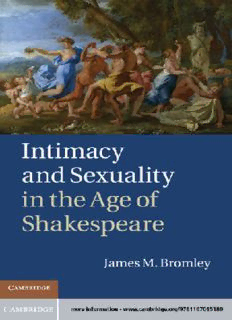
Intimacy and Sexuality in the Age of Shakespeare PDF
Preview Intimacy and Sexuality in the Age of Shakespeare
INTIMACY AND SEXUALITY IN THE AGE OF SHAKESPEARE JamesM.BromleyarguesthatRenaissancetextscirculateknowledge aboutavarietyofnon-standardsexualpracticesandintimatelifenar- ratives, including non-monogamy, anal eroticism, masochism, and cross-racial female homoeroticism. Rethinking current assumptions about intimacy in Renaissance drama, poetry, and prose, the book blendshistoricizedandqueerapproachestoembodiment,narrative, and temporality. An important contribution to Renaissance literary studies,queertheory,andthehistoryofsexuality,thebookdemon- strates the relevance of Renaissance literature to today. Through closereadingsofWilliamShakespeare’s“problemcomedies,”Christo- pherMarlowe’sHeroandLeander,playsbyBeaumontandFletcher, ThomasMiddleton’sTheNiceValour,andLadyMaryWroth’sson- netsequencePamphiliatoAmphilanthusandherproseromanceThe Urania,Bromleyre-evaluatesnotionsofthecentralityofdeep,abiding affection inRenaissance cultureand challenges our owninvestment inanarrowlydefinedintimatesphere. james m. bromley is Assistant Professor of English at Miami University.Hehaspublishedessaysonintimacy,sexualpractice,and Renaissance literature in Early Modern Literary Studies, Studies in Philology,andModernPhilology.Heisthewinnerofthe2011Martin StevensAwardforBestNewEssayinEarlyDramaStudiesfromthe MedievalandRenaissanceDramaSociety. INTIMACY AND SEXUALITY IN THE AGE OF SHAKESPEARE JAMES M. BROMLEY MiamiUniversity cambridge university press Cambridge,NewYork,Melbourne,Madrid,CapeTown, Singapore,Sa˜oPaulo,Delhi,Tokyo,MexicoCity CambridgeUniversityPress TheEdinburghBuilding,Cambridgecb28ru,UK PublishedintheUnitedStatesofAmericabyCambridgeUniversityPress,NewYork www.cambridge.org Informationonthistitle:www.cambridge.org/9781107015180 (cid:2)c JamesM.Bromley2012 Thispublicationisincopyright.Subjecttostatutoryexception andtotheprovisionsofrelevantcollectivelicensingagreements, noreproductionofanypartmaytakeplacewithoutthewritten permissionofCambridgeUniversityPress. Firstpublished2012 PrintedintheUnitedKingdomattheUniversityPress,Cambridge AcataloguerecordforthispublicationisavailablefromtheBritishLibrary LibraryofCongressCataloguinginPublicationdata Bromley,JamesM.,1978– IntimacyandsexualityintheageofShakespeare/JamesM.Bromley. p. cm. Includesindex. isbn978-1-107-01518-0(hardback) 1.Englishliterature–Earlymodern,1500–1700–Historyandcriticism. 2.Sexinliterature. 3.Intimacy(Psychology)inliterature. 4.Selfinliterature. 5.Homosexualityinliterature. I.Title. pr428.s48b76 2011 820.9(cid:3)353809031–dc23 2011043834 isbn978-1-107-01518-0Hardback CambridgeUniversityPresshasnoresponsibilityforthepersistenceor accuracyofURLsforexternalorthird-partyinternetwebsitesreferredto inthispublication,anddoesnotguaranteethatanycontentonsuch websitesis,orwillremain,accurateorappropriate. Contents Listofillustrations pagevi Acknowledgements vii Introduction:Interiority,futurity,andaffectiverelationsin Renaissanceliterature 1 1 IntimacyandnarrativeclosureinChristopherMarlowe’s HeroandLeander 29 2 Afunnythinghappenedonthewaytothealtar:The anus,marriage,andnarrativeinShakespeare 49 3 Socialstatusandtheintimacyofmasochisticsexual practiceinBeaumontandFletcherandMiddleton 79 4 Nunsandnationhood:Intimacyinconventsin Renaissancedrama 108 5 Femalehomoeroticism,race,andpublicformsofintimacy intheworksofLadyMaryWroth 145 Epilogue:Invitationtoaqueerlife 179 Notes 186 Index 204 v Illustrations 1. ThePassionatePilgrim(London,1599)signatureD5r–v. ReproducedbypermissionoftheHuntingtonLibrary,San Marino,California,andProQuest.Furtherreproductionis prohibitedwithoutpermission.Imageproducedby ProQuestaspartofEarlyEnglishBooksOnline. page21 2. England’sHelicon(London,1600)signatureAA1v–AA2v. (cid:2) C TheBritishLibraryBoard.Imagepublishedwith permissionofProQuest.Furtherreproductionisprohibited withoutpermission.ImageproducedbyProQuestaspart ofEarlyEnglishBooksOnline. 22 vi Acknowledgements ItisperhapsaptthatabookaboutformsofaffectioninRenaissancetexts should first pause to express my thanks for the relationships that have sustainedmesincethisproject’sinceptionatLoyolaUniversityChicago.I continuetoprofitimmeasurablyfromSuzanneGossett’srigorousreading ofmyworkandheruniqueandindefatigablewayofpushingmetogrowas ascholarandwriter.ChristopherCastiglia,amodelofclarityandinsight, helped me to see what this project was actually about. With his broad understandingofRenaissanceliteraryproduction,JamesBiesternurtured the inclusion of non-dramatic texts of the period in this project. Jeffrey Mastenunstintinglyofferedhisengagementwiththeworkonthisproject, andmygratitudeforhisunflaggingencouragementandmentorshipofme asascholaris,toadaptaphrase,toolittlepaymentforsogreatadebt. AtMiamiUniversity,IamneverforgetfulofhowfortunateIamtohave intelligentandsupportivecolleagues.Thisbookhasincalculablybenefitted from my conversations with Katharine Gillespie, Elisabeth Hodges, and other members of Miami’s interdisciplinary Early Modern Collective. I am much obliged to Mary Jean Corbett and Kaara Peterson, who, with keen eyes, proofread the text. At various stages, work on this project was supported by a fellowship from the Arthur J. Schmitt Foundation and by Summer Research and Assigned Research Appointments from Miami University. I also wish to extend my appreciation to the far-flung early modern scholarswhohavehelpedshapethiswork.Avaluedinterlocutorandindis- pensable friend, Will Stockton read the entire manuscript with the same acuitythathedemonstratesinhisownwork,andthisbookandmythink- ing about Renaissance sexuality are better because of him. I thank Gary TaylorforpermissiontoconsulttheOxfordMiddletoneditionofTheNice Valourpriortoitspublication.RichardStrierreadpartofChapter3inhis capacityaseditorofModernPhilology,anditismuchimprovedasaresult. Fran Dolan generously gave me constructive commentary on a draft of vii viii Acknowledgements Chapter4.Atmanytimesandindifferentlocales,thoughtfulandfriendly conversations with Will Fisher, Vin Nardizzi, and Michael Schoenfeldt have invigorated my thinking about early modern literature. I have also reapedmuchfromdiscussionbyaudiencesandseminarparticipantsatthe Modern Language Association Convention; the annual meetings of the Renaissance Society of America, the Shakespeare Association of America, and the Group for Early Modern Cultural Studies; and the Elizabethan TheatreConference. IamgratefulforthesupportofSarahStantonatCambridgeUniversity Press, and the comments from Rick Rambuss and an anonymous reader have strengthened and enriched this book. Celeste Newbrough provided theindex. Finally,LauraLeMonehastaughtmemoreaboutthevarietiesofaffec- tionthananyoneIhaveevermet.Forherpatienceandkindness,Idedicate thisbooktoher. PreviouslypublishedmaterialinChapter1isreprintedbypermissionof the publishers from “‘Let it suffise’: sexual acts and narrative structure in Hero and Leander”, in Queer Renaissance Historiography: Backward Gaze, edited by Vin Nardizzi, Stephen Guy-Bray and Will Stockton. An earlier versionofChapter3appearedas“SocialRelationsandMasochisticSexual PracticeinTheNiceValour”inModernPhilology(2010). note WhereIamnotquotingfromamoderneditionofatext,Ihaveretained earlymodernspellingandpunctuation.Forclarity,however,Ihavesilently modernizedi/j,u/v,andlongs,andwheremacronsindicatethesuspension ofaletterIhavere-insertedtheletter. Introduction: Interiority, futurity, and affective relations in Renaissance literature failures of intimacy In his 1583 The Anatomy of Abuses, Philip Stubbes famously charged that 1 drama taught audiences how to “play the Sodomits, or worse.” Stubbes’s capacious “or worse,” I would suggest, refers to certain affective relations thateventuallybecameillegibleundertherubricsofmodernintimacy.In thisbook,Imapthecirculationofknowledgeaboutthesequeeraffections, not only in the plays that Stubbes targets, but also in poetry and prose writtenbetween1588and1625.Duringthesixteenthandseventeenthcen- turies,theintimatespherecoalescedaroundrelationscharacterizedbytwo elements: interiorized desire and futurity. Interiorized desire locates the truthabouttheselfandsexualityinsidethebody,therebyorganizingand limiting the body’s pleasures based on a hierarchized opposition between depths and surfaces. Access to futurity involves the perceived sense of a relationship’sdurationanditsparticipationinlegitimatesocialandsexual reproduction. These changes, of which Stubbes’s charge is one of many indices,laidthefoundationformodernunderstandingsofnormativeinti- macy as coextensive with long-term heterosexual monogamy. Coupling, and more specifically marriage, was invested with value as a site where affection was desirable – as opposed to a primarily economic and politi- cal arrangement with emotional bonds as a secondary concern – through its figuration as the interpersonal relation with the proper combination of interiorized desire and access to futurity. Other interpersonal relations wereexcludedfromthecategory,becominginsteadwhatIcall“failuresof intimacy,”despitebeingcharacterizedbyaffect,care,andpleasureforthose involved,sometimestoagreaterdegreethanrelationstypicallyunderstood asintimateinmodernWesternculture. Nothing about the heterosexual couple inherently implies the auto- matic presence of affect, care, or pleasure, any more than any other form ofrelationality.YetmodernWesternculture’srelationaleconomyassumes 1
Description: